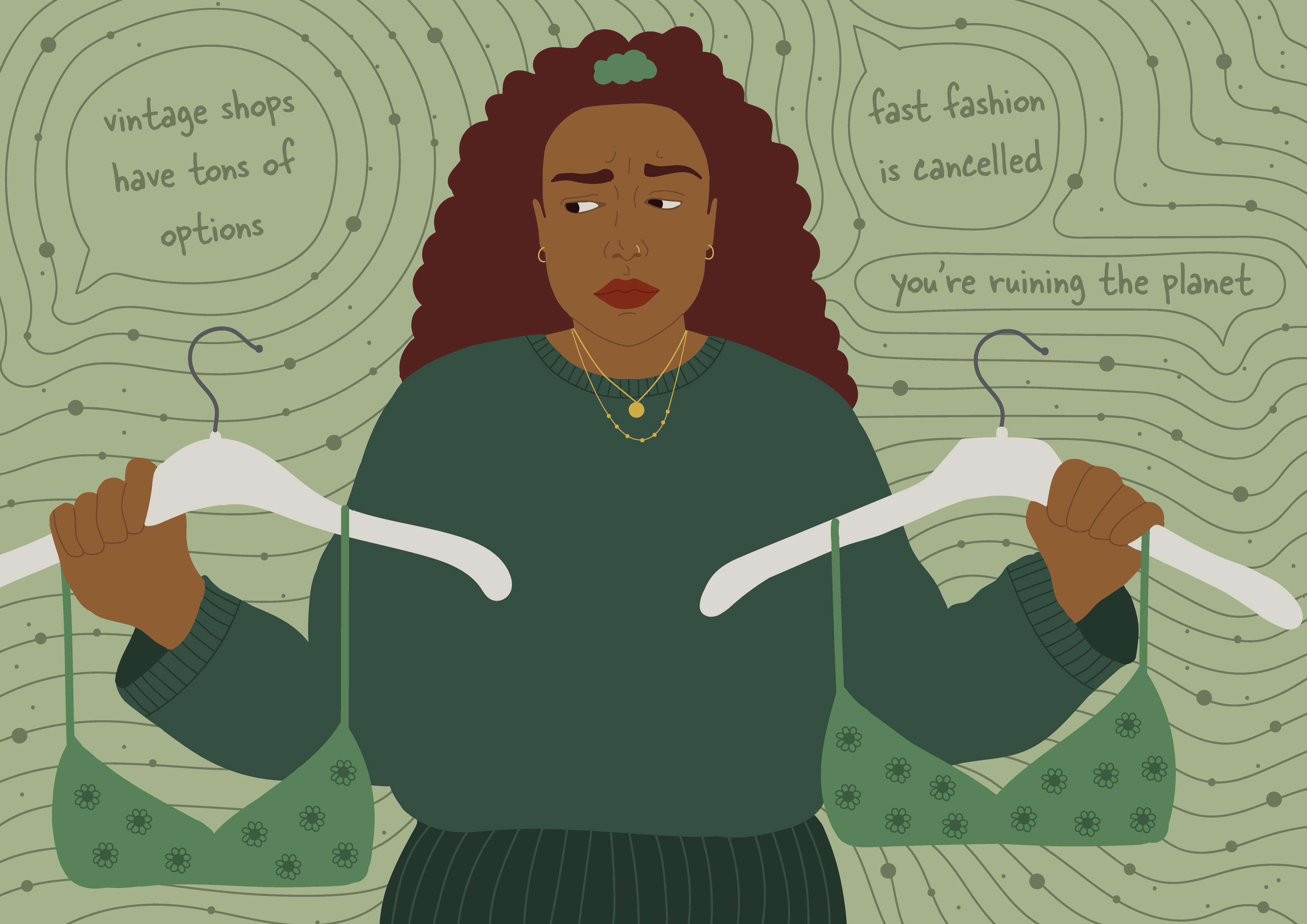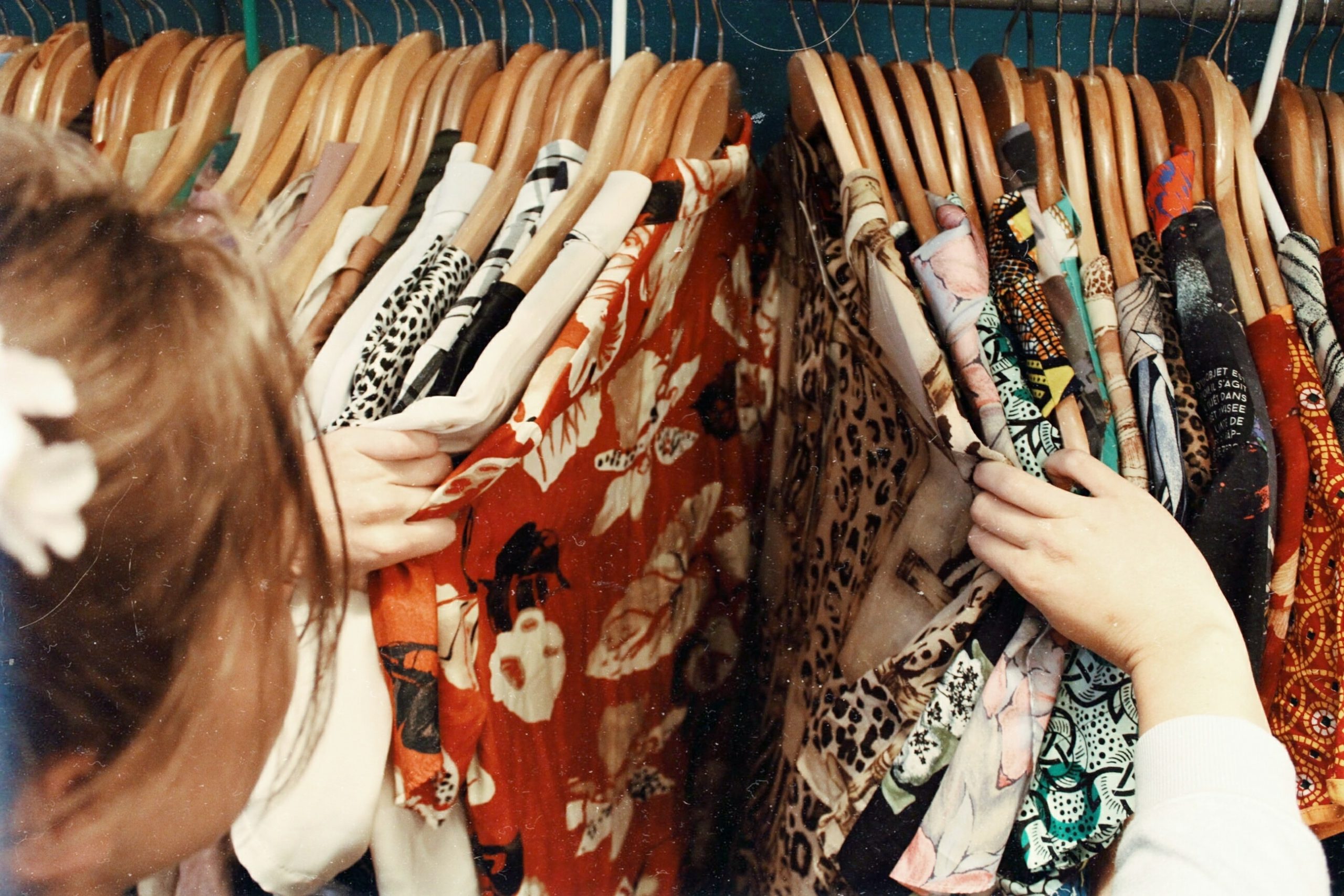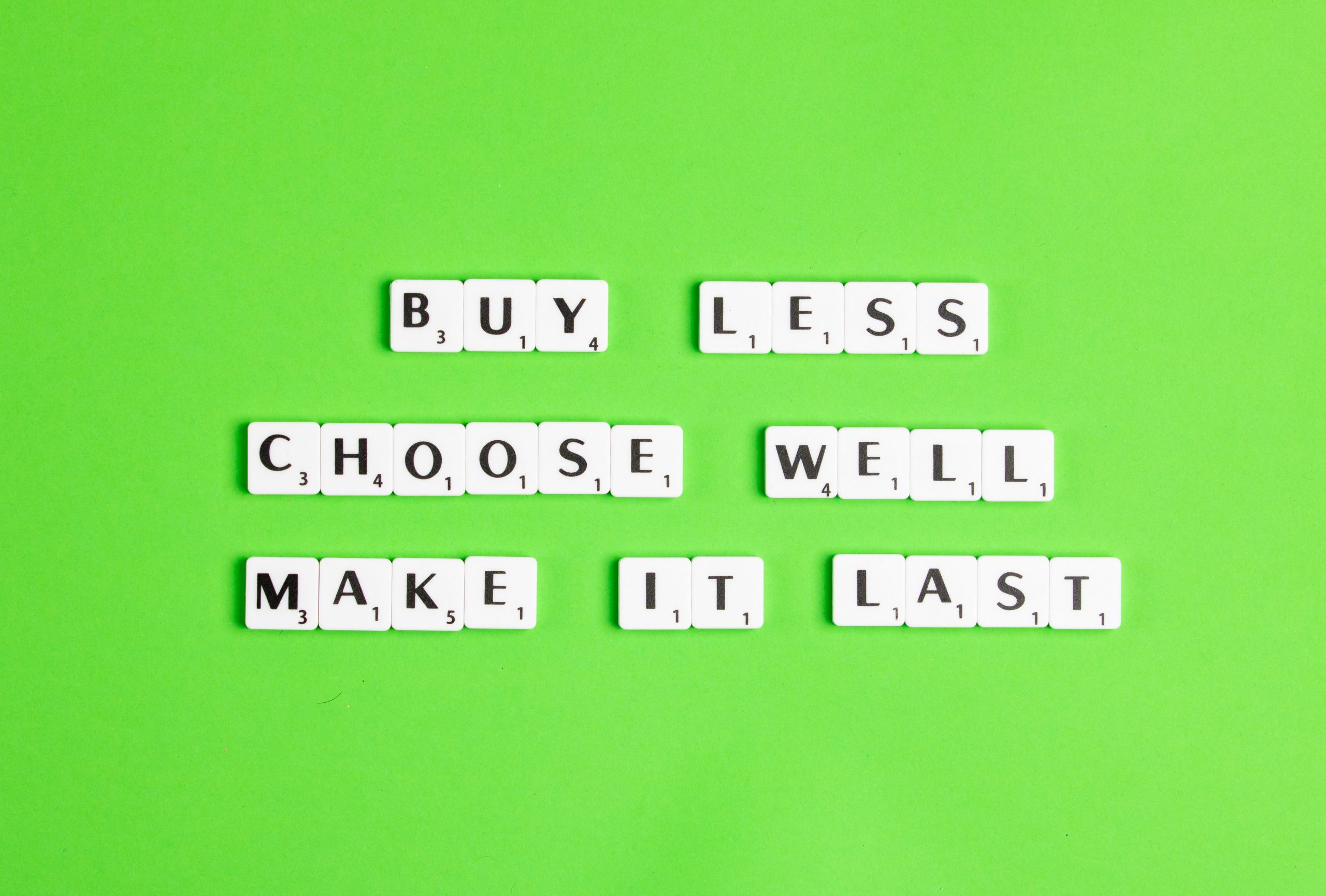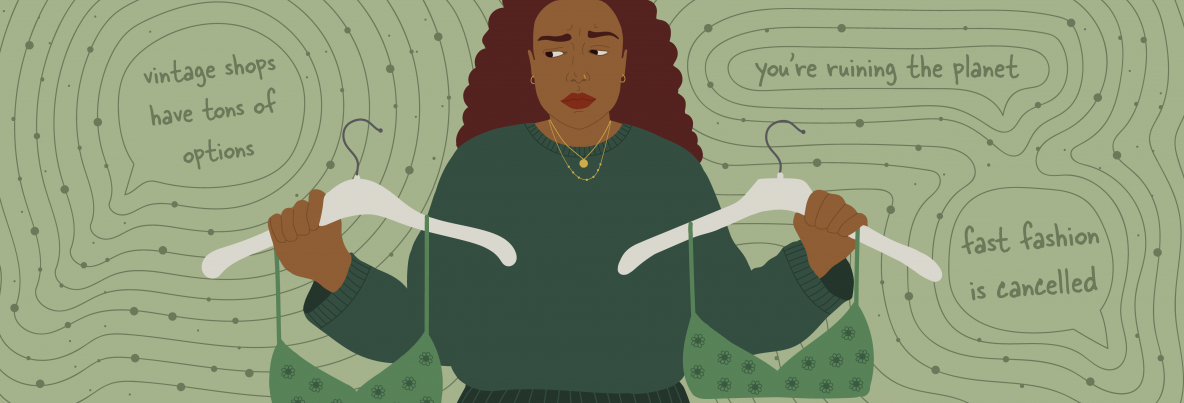'SHOP SUSTAINABLY...' BUT ONLY IF YOU'RE THIN AND RICH
The inaccessibility of sustainable fashion, and how can it change?
By Philippa Mwayi / 26 November 2020

Illustration by Philippa Mwayi
In the past 20 years, the fast fashion industry has exploded and our shopping habits have drastically changed as consequence.
In 2014, consumers bought 60% more clothing items than at the start of the millennium, but only kept the clothes for half as long. The launch of e-commerce brands such as ASOS, Missguided and Boohoo created a whole new shopping experience facilitating this frivolous consumption and for a while, we all naively bought into it - but can you blame us? They offered wider ranges of styles and sizes than most retailers and you could get a brand new outfit that was fashionable and delivered within days, all for under £20. All of sudden, you didn’t need to be a celebrity to be able to buy a new outfit for every event - and it felt good. However, as with most things, all that comes up must come down, or in this case, become heavily scrutinised.
Although many of us were blinded by the flashing ‘50% off’ banners and enticing YouTube hauls, thanks to the work of sustainability activists and educators, we quickly came to our senses and realised the damage that was being done. Dangerously high CO2 emissions, unsafe working conditions and 1.5 trillion litres of water a year are just a handful of the issues that the fashion industry has been exposed for.
Responding to this and led by an army of sustainable fashion influencers and activists, many of us are feeling the pressure to ditch our fast fashion habits and start ‘shopping slowly’. However, with most forms of activism comes gatekeeping and guilt-tripping. An element of pressure is often needed for real change to come about. But what many people fail to realise is that when it comes to shopping sustainably, there are barriers in place making sustainable fashion less accessible and until we address these, no amount of guilt-tripping will have an impact.

Photo by Becca McHaffie on Unsplash
What makes sustainable fashion inaccessible?
You may have noticed a similar characteristic amongst many of the people leading the conversation on sustainability; they are all thin, and there’s a reason for it. For a long time, many sustainable fashion brands weren’t size-inclusive and although frustrating, we accepted that due to many of them being new and upcoming brands, they couldn’t offer as much. However, even in 2020 where the sustainable fashion industry is booming, some brands are still disregarding the need for larger sizes. House of Sunny, known for their infamous green dress endorsed by Kendall Jenner, charge upwards of £100 for many of their items yet still don’t produce clothes above a size 14, smaller than the UK average for women.
Vintage shopping is framed as another option for those wanting to make their wardrobe more sustainable but you’d be naive in thinking there is any more inclusivity behind the doors of stores like COW and Beyond Retro. By its nature, vintage clothing is less likely to come in larger sizes. However, after walking into a COW store last year to browse their reworked line, a selection of clothes upcycled by an in-house seamstress, only to be greeted with over 20 garments in ‘one size fits all’, it became harder to excuse what felt like outright fatphobia. There was no specification of what this magical ‘one size’ actually was, but when what appeared to be a child-sized headband was, in fact, a top, it became crystal clear who this line was aimed at.
After sustainable brands have shut the door in your face and vintage shops may as well have a ‘do not shop here if you are fat’ sign on the door, the last option is charity shops. This route has been a go-to for those with a tighter budget and although it’s much harder to find fashionable pieces, charity shops can be home to some hidden gems. However, much like anything wholesome, it wasn’t long before it was tarnished by the greed and ignorance of others. Depop sellers have been able to make a living from buying clothes from charity shops and reselling them for four times the price, often favouring larger sizes to capitalise on the oversized clothing trends or to ‘upcycle’ into smaller items for thinner shoppers. The gentrification of charity shops has led to an increase in pricing and larger sizes are now harder to find, making what was once a valuable and inclusive resource to lower-income individuals, far less accessible.

Photo by Edward Howell on Unsplash
What can we do to make sustainable fashion more accessible in future?
In 2020, we’ve learned that we have more control than we think when it comes to demanding morality from the places we shop. We’ve forced brands into releasing staff diversity reports and being more transparent about their supply chain. here’s no reason why we can’t do the same with sizing and sustainability. If you have social media, access to a phone or email, there’s a lot you can do to make brands realise they need to be inclusive with their sizing. Especially those who are in a position of privilege, be vocal with your upset and let brands know that this is an issue that needs addressing. The same can be done with fast fashion brands. Many of them offer the necessary inclusivity and low pricing so instead of cancelling them, encourage them to be more sustainable and transparent about their garments.
It’s also important to be conscious of the influencers and activists that we follow for information on sustainable fashion. There’s more than enough room at the table for every one of these individuals to have a platform but if when looking through the list of people you follow, you’re presented with a sea of faces that look the same, it might be time to work on that. Ask yourself if the activists you follow consider social issues when discussing the importance of sustainability. If they don’t, there are plenty that do. Intersectionality within activism is key and making sure the information you consume reflects this will help us all fight for a more sustainable world.
For those struggling to shop sustainably...
Despite many people feeling left out of the conversation surrounding sustainable fashion, this hasn’t dampened our determination to reduce our environmental impact and there is still plenty that we can do, even if it’s something small. We may be feeling the pressure to boycott the likes of ASOS, Missguided or Primark but relying on these brands for their size offering or lower prices does not make you a bad person. Whilst the sustainable fashion offering is still limited, having a wardrobe that combines a selection of fast fashion pieces with items that are thrifted is still a step towards a greener lifestyle. Amid a second lockdown, getting crafty and upcycling your existing items that no longer fit or suit your style is another way you can make your wardrobe more sustainable and learn a new skill.
Although they may be harder to find, there are several sustainable fashion influencers that are inclusive with their activism and put in the work to show us it is possible to shop green at any size or price point. Aja Baber (@ajabarber), Lydia Okello (@styleisstyle), Marielle Elizabeth (@marielle.elizabeth), Mary-Alice Duff (@maryalice_duff) and Biana Caffoley (@biancacaffoley) are just a few of the amazing influencers ensuring the conversation surrounding sustainable fashion is intersectional.
However, it isn’t up to these influencers alone to make sustainable shopping inclusive; we have to amplify their voices to the masses and ensure every brand, influencer and individual recognises the barriers to sustainable fashion. We must realise that having enough money to choose where you purchase your clothes from, saying no to fast fashion or be able to walk into any store and see your size on a hanger is a privilege. If we want to achieve a greener, more sustainable society, addressing that not everybody's path is the same and putting in the work to make the movement more inclusive, will allow us to reach our goal a lot sooner than we think.
Art by
Words by
Share this article

